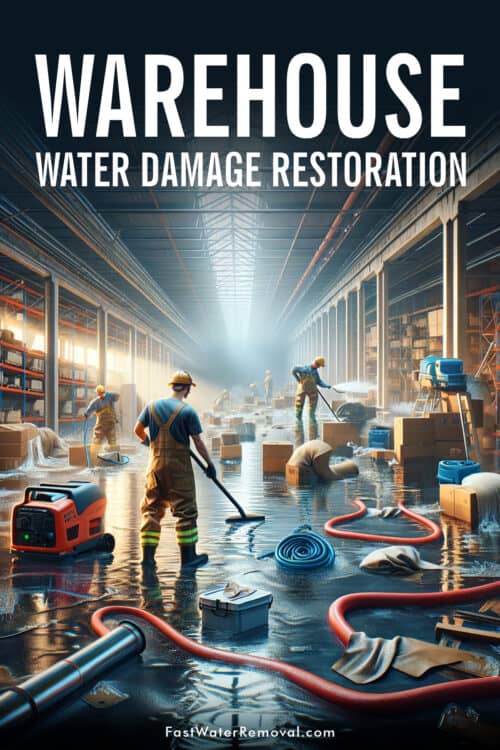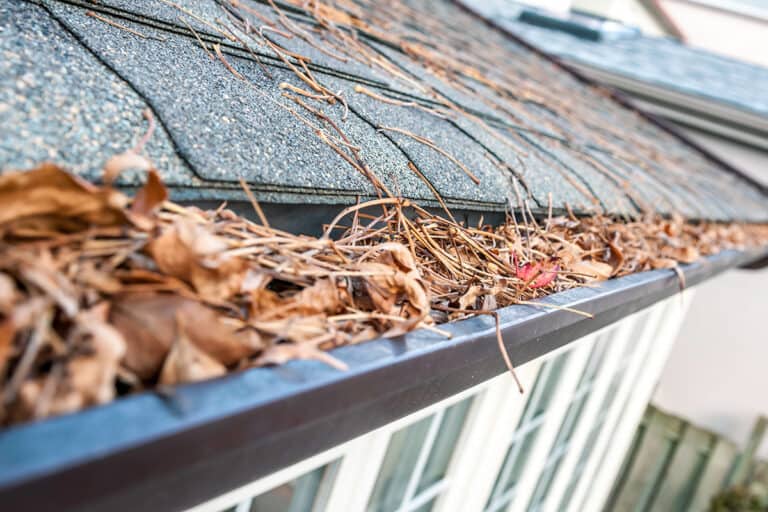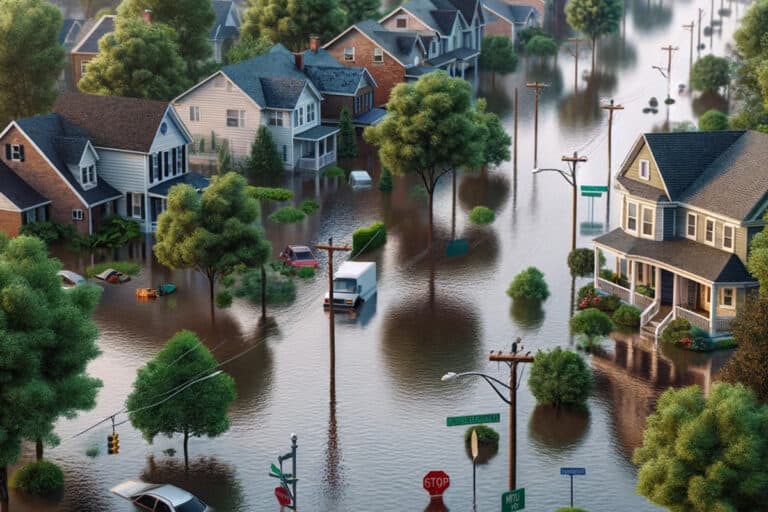Disclosure: I am compensated for purchases made through some links on this site. Click for details.
Water damage in a warehouse can be a significant setback, impacting operations, inventory, and the structural integrity of the building. It’s a complex issue that requires immediate and professional attention to prevent further loss and to restore the facility to functional condition. A thorough assessment and inspection are the first steps in the restoration process, which will identify the extent of the damage and the necessary steps to address it.
A robust restoration and repair plan must be put in place swiftly to minimize downtime and financial impact. This plan will typically include water removal and dehumidification, thorough cleaning and sanitizing, and targeted mold remediation to prevent long-term issues. In addition, the structural repair of any damages caused by the water ensures the warehouse is safe and operational.
Key Takeaways
- Water damage requires immediate action to prevent further losses.
- A detailed water damage restoration plan is crucial for effective recovery.
- Professional services ensure proper mold remediation and structural repairs.
Understanding Water Damage in Warehouses
In the context of warehousing, water damage can inflict serious harm on structures, inventory, and equipment. Businesses need to understand the various origins and manifestations of water damage to effectively mitigate risks and implement remediation strategies.
Causes of Water Damage
The onset of water damage in warehouses is often due to leaks, broken pipes, or natural disasters such as floods. Roofs are particularly vulnerable to water penetration, especially when subjected to extreme weather conditions like heavy rain, snow, or ice. Faulty HVAC systems or blocked drains can also lead to the accumulation of moisture, which may result in damage over time.
Types of Water Damage
Water damage within warehouses can be categorized into visible and concealed types. Visible damage is evident on floors, walls, or merchandise, manifesting as stains, warping, or mold growth. Concealed damage, potentially more detrimental due to its insidious nature, can affect internal structures and cause long-term integrity issues. In both instances, it is crucial to identify and address the root causes promptly.
Recognizing Signs of Water Damage
Recognizing water damage promptly depends on vigilant monitoring of the warehouse environment. Signs include noticeable dampness, musty odors, or the presence of mold on walls or ceilings. Regular inspections of roofs and plumbing systems are integral in early detection, as is checking for water spots or corrosion on equipment, which could indicate moisture issues.
Damage Assessment and Inspection
When addressing water damage in warehouses, the first stage is a careful inspection to scope the level of damage and inform the restoration process. Accurate documentation is also pivotal for supporting insurance claims.
Initial Inspection Procedures
Upon arrival at the warehouse, specialists begin with an initial inspection to identify the source of water and classify the contamination level. They use specialized equipment such as moisture detectors and hygrometers to measure moisture saturation. This step is crucial for planning the immediate measures needed to prevent further damage.
Determining the Extent of Damage
The extent of water damage can vary, from minor leaks affecting inventory to significant flooding that compromises the structural integrity. Professionals evaluate all affected materials, including walls, floors, and machinery. They then categorize and list items to determine what can be restored and what may need replacement.
Documentation for Insurance Claims
Documentation is essential for insurance claims. Restoration experts meticulously photograph and log all instances of property and inventory damage. This information, alongside the water damage classification and a restoration plan, assists warehouse owners in filing accurate insurance claims to cover the repair and restoration expenses.
Restoration and Repair Plan
A comprehensive restoration and repair plan is vital for mitigating the impacts of water damage in a warehouse setting. This structured approach ensures that time-sensitive actions are executed efficiently to restore operations and minimize both property losses and business interruption.
Developing an Effective Plan
When creating a warehouse water damage restoration plan, businesses must assess their vulnerabilities to determine the most critical response actions after an emergency. The plan should detail procedures for water extraction, drying, dehumidification, and sanitation, and list equipment necessary for each step. A clear, actionable strategy can drastically reduce downtime in the wake of water damage.
Priority Areas and Sequential Repair
Identifying priority areas sets the sequence for repair and restoration tasks, allowing a logical flow to the recovery process. Initial efforts typically focus on areas housing critical infrastructure or high-value inventory. This prioritization helps in allocating resources effectively, ensuring essential systems such as electrical and HVAC are made safe and operational ahead of less critical spaces.
Water Removal and Dehumidification
The initial focus in warehouse water damage restoration is the prompt removal of water and the control of humidity levels. These steps are essential to prevent further damage and to begin the restoration process.
Immediate Water Extraction
After identifying and stopping the source of water ingress, the immediate priority is water removal. High-powered extraction units and submersible pumps are used to clear standing water from the warehouse floor, which is crucial to prevent the deterioration of stored items and structural components. Speed is of the essence since prolonged exposure to water can lead to significant losses and structural damage.
Industrial Dehumidifiers and Air Movers
Once most of the water is extracted, dehumidification plays a pivotal role in restoring atmospheric conditions within a flooded warehouse. Industrial-grade dehumidifiers work to pull residual moisture from the air, while air movers ensure constant airflow across walls, floors, and other surfaces, facilitating the drying process. This combination is critical to thwart the development of mold and mildew, which can compromise both the integrity of the warehouse and the health of its occupants.
Cleaning and Sanitizing
Cleaning and sanitizing are critical steps in restoring a warehouse after water damage. They involve thoroughly removing contaminants and applying antimicrobial treatments to eliminate mold and neutralize odors.
Cleaning Practices
Effective cleaning practices are essential to address water damage in a commercial warehouse. First, professionals assess the area to determine the extent of the damage. They then employ industrial-grade equipment—such as wet vacuums and steam cleaners—to remove standing water and cleanse surfaces. Thorough washing may also include the use of foam, abrasive powders, and chemical sprays specifically designed to treat contaminated surfaces and prevent the growth of harmful microorganisms.
Sanitizing and Deodorization
Sanitizing and deodorization follow the initial deep cleaning. Specialized chemical reagents are applied to sanitize surfaces, targeting mold, mildew, bacteria, and other potentially harmful pathogens. Deodorization techniques are used to address any lingering odors, often through the use of fogging equipment and air scrubbers, ensuring that the space is not only clean but also free of any unpleasant smells. Remediation experts use EPA-approved antimicrobials and deodorizers to ensure a safe and odor-free environment, aligning with industry standards set forth by organizations such as the IICRC.
Mold Remediation and Prevention
Effective mold management in warehouses involves both the remediation of existing mold and the implementation of measures to prevent future mold growth. This ensures not only the structural integrity of the warehouse but also the health of its occupants.
Remediation of Existing Mold
When a warehouse is confronted with mold, it is crucial to act swiftly. The remediation process starts with a thorough inspection to identify the source of the mold growth, followed by the development of a detailed remediation plan. This plan should include establishing containment areas to prevent the spread of spores during cleanup. Professional remediation teams use special equipment and EPA-approved chemicals to clean and disinfect all affected surfaces, effectively removing mold and mildew.
Highly affected materials, including drywall or insulation, often require complete removal and replacement. The area must be kept dry and well-ventilated during and after the process to ensure that mold does not return.
Preventive Measures Against Mold
Preventing mold in a warehouse requires maintaining low humidity levels, proper ventilation, and immediate response to water damage. It is recommended to opt for water damage recovery professionals who understand how to address and repair the issues to avert future mold growth. Structural materials should be inspected regularly for signs of dampness or damage.
Installing dehumidifiers, maintaining the HVAC system, and applying mold-resistant coatings are additional steps that can help prevent mold proliferation. Training staff to recognize and report early signs of moisture and a musty smell can also be significant in mold prevention, safeguarding both the warehouse’s products and its workers’ health.
Repairs and Structural Restoration
In the aftermath of water damage, restoring the structural integrity of a warehouse is critical. It involves both repairing the damaged parts of the building and ensuring the safety of the roof and electrical systems.
Repairing Damaged Structures
When water damage impacts a warehouse, the repair process often necessitates a thorough assessment of the structural damage. Repairs may include reinforcing weakened beams, replacing compromised flooring, and restoring damaged walls. Specialists in water damage restoration have the expertise to evaluate which structural repairs are necessary and can determine the extent of water infiltration.
Roof and Electrical System Repairs
The roof of a warehouse is vital for protecting the interior and its contents from further water damage. Roof repairs may involve patching leaks, replacing damaged materials, and ensuring proper drainage. Similarly, the electrical system must be inspected for safety; this includes replacing wet electrical components, checking the wiring for corrosion, and ensuring that the HVAC system is fully operational to prevent moisture-related issues.
Preventive Measures and Maintenance
Effective warehouse water damage prevention hinges on robust strategies and adherence to a maintenance schedule designed to tackle potential issues like leaks and drainage system failures. Preemptive actions can save businesses from costly repairs and protect their inventory effectively.
Implementing Preventive Strategies
To mitigate the risk of water damage in warehouses, it’s critical to implement preventive strategies. This includes inspections to identify cracks or weak points where water might enter the building. The role of preventive maintenance is vital to ensure the reliability and longevity of the warehouse structure. Additionally, installing proper drainage systems is a proactive measure to manage and redirect water away effectively.
Regular Maintenance Schedule
Maintaining a regular maintenance schedule is crucial for the ongoing health of warehouse facilities. It should encompass routine checks of all potential problem areas, especially focusing on plumbing to detect any leaks early. Industry standards suggest that maintaining the hot water system and regular flushing of plumbing can prevent bacterial growth and maintain water quality. Regular upkeep helps to catch issues before they escalate, ensuring that water damage and its associated disruptions are kept at bay.
Navigating Insurance and Financial Considerations
When dealing with warehouse water damage restoration, understanding insurance coverage and the claims process is critical. Businesses need to be prepared for the financial complexities associated with commercial property damage caused by water.
Understanding Water Damage Insurance Coverages
Water damage insurance is pivotal for the financial protection of a warehouse. Policies differ greatly, so one must carefully review what types of water damage are covered. Commonly, insurance will cover events like burst pipes and storms, but may not include flood damage unless specifically added. Therefore, warehouse owners should ascertain that their policy encompasses all potential water-related risks to their property.
Filing an Insurance Claim
In the event of water damage, filing an insurance claim is the first step to mitigate financial loss. A warehouse owner should promptly notify their insurance provider to initiate the process. Documentation is crucial; they should compile a thorough inventory of damages and gather all relevant evidence, such as photos and repair estimates. A restoration company can often assist in these areas, providing expert evaluations and detailed records that support the claim. Timeliness and accuracy are essential to ensure the insurance claim is processed smoothly and efficiently.
Technology and Innovations in Water Damage Restoration
Emerging technologies in the water damage restoration industry are enhancing the efficiency and effectiveness of post-water damage recovery. They equip technicians with advanced tools and methodologies that improve response time and restoration outcomes.
Advanced Detection and Drying Technology
The equipment used for detecting water presence has seen significant advancements. Infrared cameras and thermal imaging devices are now common tools for identifying moisture in buildings, allowing for rapid and accurate moisture assessments. Storm sensors and hygrometers are also frequently utilized to monitor humidity levels accurately. Once moisture is detected, innovative drying systems such as high-speed air movers and dehumidifiers capture and extract water vapor, thus expediting the drying process and preventing mold and structural damage.
Innovations in Restoration Techniques
Technicians in the water damage restoration field are continually adapting to new restoration techniques. One significant development is the usage of remote monitoring technology that enables the real-time tracking of equipment and environmental conditions. This technology ensures optimal drying conditions are maintained and alterations are made promptly when necessary. Additionally, the industry is witnessing the introduction of eco-friendly and less invasive restoration methods, which not only restore properties more efficiently but also support environmental sustainability efforts.
Professional Restoration Services
When dealing with commercial water damage, quick and professional action is crucial. A reputable restoration company provides speedy and efficient service to restore the affected area, minimizing the operational downtime for the business.
Choosing a Restoration Company
The selection of a restoration company is a critical decision that can influence the speed and success of water damage mitigation. Businesses should seek companies that offer 24/7 emergency services with a robust track record. It is imperative that they can service a vast range of locations, enabling them to respond promptly and prevent further damage.
The Role of Technicians in Restoration
Technicians are the backbone of any restoration process, playing a pivotal role in managing commercial water damage. They are trained to handle water removal, drying, and sanitization with precision, and serve as emergency responders equipped to assess the situation and initiate the recovery process. For instance, companies such as Flood Zone Disaster Recovery Solutions specialize in warehouse water damage, highlighting the specialized nature of the industry and the need for experienced technicians ready to act.
Conclusion
In the realm of warehouse water damage restoration, prompt action is imperative to mitigate property damage and safeguard health. Certified experts are equipped to handle emergencies, utilizing proven strategies to restore affected premises. They emphasize rapid response to prevent the proliferation of mold and bacteria, which can have detrimental health consequences if not addressed quickly.
Warehouse managers should have a contingency plan for unforeseen water-related disasters. Ensuring that water damage restoration services are readily available can be a key factor in the operational continuity of a warehouse. This timely intervention also assists in preserving the integrity of stored goods, minimizing the potential for loss.
Regular maintenance, including preventative measures, underpins the efficacy of any mitigation strategy. Warehouses must conduct frequent inspections and repairs of roofing and plumbing systems. This proactive approach can significantly reduce the severity and cost of potential water damage incidents.





